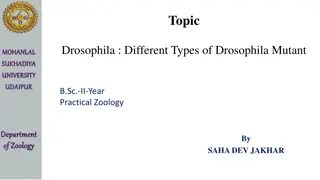Understanding Dermatomycosis and Dermatophytes in Zoology
Dermatomycosis, caused by dermatophytes such as Trichophyton, Microsporum, and Epidermophyton, is a common skin infection by fungi. This article explores the characteristics, classification, development, preferred sites of infection, and more related to dermatophytes in the field of zoology.
Download Presentation

Please find below an Image/Link to download the presentation.
The content on the website is provided AS IS for your information and personal use only. It may not be sold, licensed, or shared on other websites without obtaining consent from the author. Download presentation by click this link. If you encounter any issues during the download, it is possible that the publisher has removed the file from their server.
E N D
Presentation Transcript
Mustansiriyah University College of science Biology Dept. Zoology 4th class Zoonoses lab. (5)
Dermatomycosis {DERMATOPHYTES} Dermatomycoses are infections of the skin, hair or nails by fungi. The principal causative agents are dermatophytes, which are subdivided into three groups (genera): 1. Microsporum spp., 2. Trichophyton spp. 3. Epidermophyton floccosum. The three genera are distinguished by the form of the spores, or macroconidia.
CHARACTERISTICS Trichophyton: thin-walled, smooth, four to six septa Microsporum: thick-walled, with projections five to more septa Epidermophyton: thick-walled, pear to oval shaped four or fewer septa Besides the dermatophytes, yeasts are also capable of causing skin disorders. The most frequent agents in this case are Candida spp. and Pityrosporum.
DEVELOPMENT OF A DERMATOPHYTOSIS direct contact with infected persons or animals, but it is more often a question of contact with fungal spores. These spores are contained in epithelial (skin) elements of infected persons everywhere in our environment. The floors of communal shower stalls and changing rooms are major sources of infection. For the development of an infection, however, more is needed than contact alone. Dermatophytes prefer warm, moist conditions. This is why a dry, intact skin constitutes a virtually impenetrable barrier. But the chance of infection is encouraged by everything that has an adverse influence on the situation.
DERMATOPHYTES - PREFERRED SITES OF INFECTION Most dermatophytes have been found to have a preference for certain situs. A preference for growth in and around the hair, in the horny layer of skin, in the moist, warm folds of the skin, or just under the nails. Trichophyton species have been found to have the greatest adaptability. Epidermophyton floccosum occurs principally in the large flexure lines and around the foot. Microsporum chiefly attacks the scalp and glabrous skin. Furthermore, the preferred sites of infection of dermatophytes are, to a certain extent, also determined by the situs where the skin comes into contact with the fungal spores.

















































